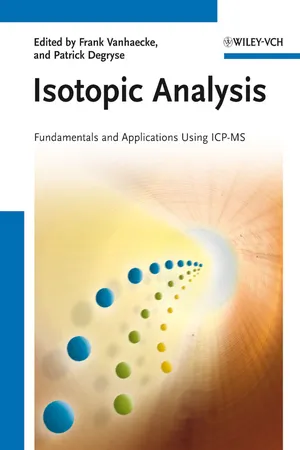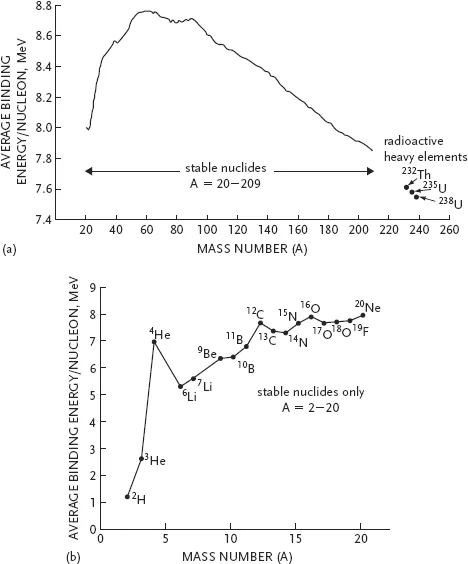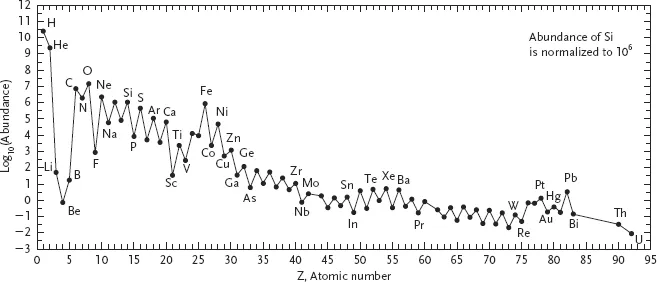![]()
Chapter 1
The Isotopic Composition of the Elements
Frank Vanhaecke Kurt Kyser
1.1 Atomic Structure
Early in the twentieth century, Rutherford realized that Thomson’s late nineteenth century plain cake model for the atom, describing the atom as consisting of electrons floating around in a positive sphere, had to be replaced by a “Saturnian” model, describing the atom as consisting of a small central nucleus surrounded by electrons, rotating on rings [1]. This view was supported by a study of the behavior of a beam of α particles (see below, particles resembling the nucleus of an He atom, thus consisting of two protons and two neutrons) directed on to a very thin Au metal foil, known as the Geiger–Marsden experiment [2]. Since only a minor fraction of the α-particles were recoiled or deflected, and for the majority the path was not affected, it had to be concluded that for the largest part, an atom consists of empty space. According to Bohr’s later model [3], the atom contains a nucleus composed of positively charged protons and neutral neutrons, having approximately the same mass. This nucleus is a factor of ∼104 smaller than the size of the atom (although the concept of size itself is not self-evident in this context) and holds practically all of its mass. As they both reside in the nucleus, protons and neutrons are also referred to by the common term nucleon. The negatively charged electrons are substantially lighter (almost 2000 times) and rotate around the central nucleus in different orbits (also termed shells), corresponding to different energy levels. Subsequently, insight into the atomic structure has evolved tremendously and a multitude of other particles have been discovered, but for many chemical considerations – including a discussion of isotopes – the Bohr model still largely suffices.
As all protons carry the positive unit charge (1.602 × 10ࢤ19 C), they mutually repel one another. This electrostatic repulsion is overcome by the so-called nuclear force [4]. This is a very strong force, but effective only within a very short range. In fact, the very short range over which this force is effective even causes the largest nuclei (e.g., those of U) to be unstable (see below). Further clarification of the nature of this nuclear force requires a more thorough discussion of the atomic structure, including a discussion on quarks, but this is beyond the scope of this chapter. Electrostatic attraction between the positive nucleus and the orbiting negative electrons provides the centripetal force required to keep the electrons from drifting away from the nucleus.
1.2 Isotopes
The chemical behavior of an atom is governed by its valence electrons (electron cloud) and, therefore, atoms that differ from one another only in their number of neutrons in the nucleus display the same chemical behavior (although this statement will be refined later). Such atoms are called isotopes and are denoted by the same chemical symbol. The term isotopes refers to the fact that different nuclides occupy the same position in the periodic table of the elements and was introduced by Todd and Soddy in the early twentieth century [5].
To distinguish between the isotopes of an element, the mass number
A – corresponding to the sum of the number of protons and the number of neutrons (the number of nucleons) in the nucleus – is noted as a superscript preceding the element symbol:
AX. The atomic number
Z, corresponding to the number of protons in the nucleus, may be added as a subscript preceding the element symbol
but is often omitted as this information is already inherent in the element symbol.
As a result of their difference in mass, isotopes of an element can be separated from one another using mass spectrometry (MS), provided that they are converted into ions. In fact, this is exactly how isotopes were discovered: Thomson separated the ion beams of two Ne isotopes using a magnetic field, while their detection was accomplished with a photographic plate [6]. With a similar setup, typically referred to as a mass spectrograph, Aston was subsequently able to demonstrate the existence of isotopes for a suite of elements [7].
Although several techniques provide a different response for the isotopes of an element, for example, infrared (IR) spectroscopy, nuclear magnetic resonance (NMR) spectroscopy and neutron activation analysis (NAA), MS is the technique of choice for the majority of isotope ratio applications. The isotopic composition of the light elements H, C, N, O, and S is typically studied via gas source MS, and for 14C dating, accelerator mass spectrometry (AMS) is replacing radiometric techniques to an increasing extent. For isotopic analysis of metals and metalloids, thermal ionization mass spectrometry (TIMS) and inductively coupled plasma mass spectrometry (ICP-MS) are the methods of choice. This book is devoted to the use of (single-collector and multi-collector) ICP-MS in this context and its basic operating principles, capabilities, and limitations are discussed in Chapters 2 and 3.
The relative abundance of one nuclide of the element M (1M) is calculated as the amount (number of atoms N or number of moles n) of nuclide 1M divided by the total amount (number of atoms or number of moles) of the element M:
for an element with m isotopes.
1.3 Relation Between Atomic Structure and Natural Abundance of Elements and Isotopes
Except for the lightest atoms, the binding energy per nucleon is remarkably stable (varying only from 7.6 to 8.8 MeV) for the naturally occurring elements (Figure 1.1). On the basis of this curve, it is understood that fission of a heavy nucleus into lighter nuclei (e.g., in a nuclear reactor) or fusion of two H atoms into He (the basis of solar energy) are exo-energetic because the process results in nuclei/a nucleus characterized by a substantially higher binding energy per nucleon.
With the lighter atoms (see Figure 1.1b), nuclei with an even number of protons and an even number of protons show a higher binding energy per nucleon and thus higher stability (compare, e.g., the binding energies for 4He and 3He, 12C and 13C, and 16O and 17O). In addition, elements with an even number of protons, reflected by an even atomic number Z, are more abundant in Nature than those with an uneven number (Figure 1.2).
This variation in binding energy per nucleon also exerts a pronounced effect on the isotopic composition of the elements, especially for the light elements. “Even–even isotopes” for elements such as C and O (12C and 16O) are much more abundant than their counterparts with an uneven number of neutrons (13C and 17O). Despite the overall limited variation in binding energy per nucleon as a function of the mass number for the heavier elements, its variation among isotopes of an element may vary substantially, leading to a preferred occurrence of even–even isotopes, as illustrated by the corresponding relative isotopic abundances for elements such as Cd and Sn (Table 1.1). In both the lower (106Cd through 110Cd) and the higher (114Cd through 116Cd) mass ranges, only Cd isotopes with an even mass number occur. In addition, the natural relative isotopic abundances for 113Cd and, to a lesser extent, 111Cd are low in comparison with those of the neighboring Cd isotopes with an even mass number. Similarly, Sn, for which 7 out of its 10 isotopes are characterized by an even mass number, the isotopes with an odd mass number have a lower natural relative abundance than their neighbors.
Table 1.1 Isotopic composition of Cd and Sn according to Böhlke et al. [11].
1.4 Natural Isotopic Composition of the Elements
As a first approximation, it can be stated that all elements ha...





